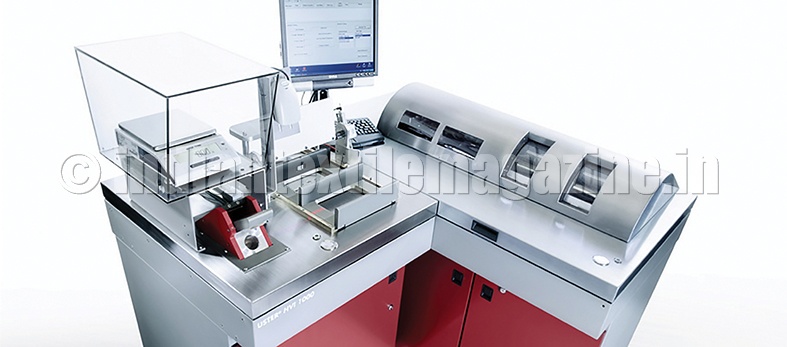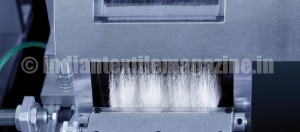China’s raw cotton auctions offer bargain prices, but is it a risky business for spinners? Huge quantities of raw cotton are being auctioned in China during July and August. As much as 11.3 million tons have been offered at current market prices, as the Chinese authorities try to offload the country’s massive stockpiles. This is good news for spinners. But there could be serious quality risks, says David McAlister, Product Manager for Fiber Testing at Uster Technologies, in an exclusive interview to The Textile Magazine.

Textile Magazine (TM): Over 11 million tons of stored cotton is being thrown onto the Chinese market. What does this mean for the industry?
David McAlister (DMA): This situation was always anticipated. The world has too much cotton, so it was expected that stocks would be unloaded and therefore world prices would be impacted.
TM: The cotton to be auctioned is from the crop of 2011 and 2012, both domestic and imported cotton.
DMA: This means that the offered cotton has been in storage for three to four years. Quality problems are inevitable: color loss called ‘yellowing’ and deterioration in spinning quality are my biggest concerns with long-term storage of raw material. It is well known that the raw cotton quality will degenerate over time.
TM: So you see a quality issue. But charging current market prices for cotton harvested in 2011 seems to be a bargain, doesn’t it?
DMA: Buyers of this cotton won’t know much more than the price and the year it was produced. The original quality information for these bales is now outdated, because of the quality changes over the years it has been in storage. It would be impossible to estimate how much the quality has reduced, as there would be no way of knowing under what conditions the raw material was stored. Storage conditions have a significant influence on quality, and therefore also on the cotton price. But my concerns are more about quality rather than price.
TM: Cotton price has always been a key variable for spinners. But surely they must deal with the possibility that they get more and better cotton at a lower cost – or the reverse?
DMA: Quality issues are generally more costly, with greater risks for the spinner. These costs also mount during the conversion process, from the raw material to yarn and fabric. My biggest concern regarding the auction of cotton from long-term storage is the change in quality and how spinners would suffer from this. Spinners might well not realize that the original classing data sent with the bales no longer matches the actual quality of the cotton after lengthy storage. Spinners rely on this data for accurate mixing of the cotton at the start of the process. If the raw material quality falls short, it will inevitably impact the final yarn quality. The implications are potentially disastrous: lower yarn selling prices, quality claims, damaged reputation and ultimately lost customers. It could be a worst-case scenario for the spinning mill…
TM: So this puts the spinners in a situation where they are gambling with their profit and reputation?
DMA: Not necessarily. The solution is quite simple. The cotton needs to be tested again. Using HVI to test this cotton can provide accurate quality parameters for the offered cotton. So the spinners can make informed purchasing decisions and set up their yarn production processes as usual, based on the factual and up-to-date information.
TM: Is retesting not a bit overcautious?
DMA: The facts are unavoidable, in long-term storage. No matter how perfect the conditions, the color grade of raw cotton changes. It’s just natural. Since the color grade is a key parameter for purchasing as well as for correct mixing in the spinning mill, it seems obvious to test a sample before bale laydown, even better before negotiating and buying cotton. How would it be possible to make decisions for the mix without knowing the real quality of the cotton? Pre-production testing of cotton from long-term storage would avoid countless problems. And, by the way, all Chinese cotton is graded using HVI, including the color. So, there is a good reference point for color changes by comparing the pre- and post-test condition on the same type of instrument.
TM: If you are asking spinners to equip their laboratories with a cotton classing instrument, how can they assess the scope for investment?
DMA: It is essential that spinners take account of increasing global yarn quality requirements. In the immediate future, it will be equally vital that they evaluate the risks of using raw cotton from long-term storage against these demands. Ignoring these risks could have serious financial consequences.
A 2002 study by Cotton Incorporated showed that a typical spinner producing 210,000 kg of 30/1 Ne yarn per week could lose 635,000 Euros ($700,000) every week because of barré faults showing up in the finished fabric. Color variation in the raw cotton mix is a major cause of the barré effect appearing as striping in the fabric.
From those independent figures, we can see that preventing barré defects for just one week would easily cover the cost of the USTER HVI 1000 instrumentation needed to protect the mill against these losses and boost its hard-won profit margins. It’s a clear investment payback on an effective solution, guaranteeing that customers receive the quality they require.
TM: What would you recommend to Chinese spinners?
DMA: I have heard some Chinese spinners say they won’t buy cotton at the auctions for high-quality yarn aimed at demanding application. Personally, I think that some smart spinners could take the chance of a competitive advantage from this situation, particularly if color change is the only issue with the cotton they purchase. In fact, no one is saying this cotton would necessarily be of poor quality.
Accurate testing of this raw material will enable the spinning mill to select bales based on the current quality parameters to produce the consistent yarn quality their customers demand. Proper quality awareness here means that spinners can uphold their standard and reputation, while also seizing the opportunity to minimize raw material costs.


